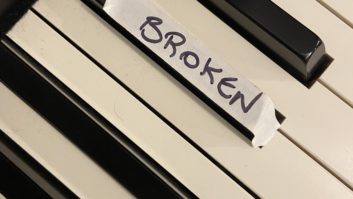On his Continuing Adventures In Software, Rich Tozzoli finds himself pondering the future path through the high-resolution landscape.
This article was spurred on by a recent chat with Bob Ludwig about high-resolution audio. The P&E Wing is continuing its great work to help inform the public, artists and producers about the realities of high-resolution audio production and delivery. It’s certainly an interesting topic, and one that is sure to have a lot of opinions (imagine that in our business!).
When we first opened up the topic of working with high-resolution audio, it really got me thinking. How do we track it, mix it, produce it and deliver it to the all-important end consumer? Also, what exactly is high-resolution audio? That will probably be open to discussion, but logically, it should be anything above 16-bit, 44.1 kHz CD-quality audio. Certainly, we should think of 24-bit/48 kHz as being the absolute minimum standard. That could then push itself up into the domain of DSD (Direct Stream Digital) and 24-bit/192 kHz audio.
We certainly have the capabilities in today’s DAW production environment to track and record hi res. We’ll discuss that more on that shortly, but then how do we get it to the consumers, and do they care? Will they pay more for it or should this just be the new normal?
DSD and the likes of 96 kHz (and up) have been around for years now, with minimal mass consumer acceptance. That, to me, is because the delivery, and its message, have been too complex. There are lessons to be learned from the whole 5.1 surround sound experience, where we thought the consumers would lap it up happily. So we went out and made it for them with some incredible sounding products—some of them new, and some of them remixed. But confusing formats, messages and playback systems kept the success to a minimum.
There’s a good reason iTunes, AAC and MP3 have succeeded. They’re easy. Do I like recording high res and wish I could deliver it all to the consumer? Absolutely! But do I also buy downloads on iTunes? Absolutely! In fact, I’ve probably purchased more music in the last two years than the last five years before that combined—because it’s a few clicks away. I can literally think of an album, download it from iTunes, have it sync via the cloud to my phone and play it in my car via Bluetooth in minutes. No muss, no fuss and minutes later, I’m enjoying the tunes.
Interestingly, I use my car as an audio quality barometer, even though I mix on studio monitors at home. That’s because the car is where I do most of my listening, and I literally had the dealer find me a vehicle with an upgraded, top-of-the-line Harman Kardon system with full subwoofers and six speakers. I dialed it in to sound like my mix room, and use it to not only check my mixes, but also to enjoy music listening.
I download my mixes (either the TV tracks or record projects) at the delivery rate of 16-bit/48 kHz into my phone. I notice without question that my mixes, and anything on CD, have more air on top and bass response on the bottom. AACs and MP3s sound fine, but CDs and hi-res mixes (even 16 bit ones) sound better. I actually have to turn the bass and treble up in my car on downloaded AAC mixes to make them sound good— compared to a CD—which we’ve had around since the early 1980s! Come on, we can do better.
Don’t get me started on satellite radio. The audio bandwidth is so limited, I hear phasing, flanging, artifacting and so on. I hear tracks I’ve mixed, and I shake my head in disgust. Anywayyyyyyy….
To dig a little further into the issue, I asked my good friend Richard Chycki, known for his engineering/ mixing/production work with bands like Rush, Dream Theater and Aerosmith, about his thoughts on hi-res audio.
“I output my mixes at 96 kHz/24-bit whenever possible,” he said. “If I’m mastering a project, I’m often asked by the label to provide both down-sampled 44.1 kHz/16-bit audio and 96 kHz/24- bit audio.”
He continued, “The hat I wear for a particular project sometimes dictates the resolution of the final product. For example, if I’m hired to mix a project and didn’t track it, it might come in at 44.1 kHz (hopefully 24-bit) or 48 kHz. If possible, I’ll up-sample the project so plug-ins are running at greater resolution and any upper harmonics generated by any analog equipment or plug-ins make it to the finished master.”
“With respect to past projects, Rush studio albums, mixed in both stereo and 5.1, are all output at 96 kHz/24-bit,” he continued. “Live releases are usually mixed back to the multitrack rig for tight sync accuracy for video, so they are output at the same sample rate as the original multitrack masters— either 96 kHz/24-bit or 48 kHz/24-bit.”
Everyone has his own concept of working in “high res.” The last two projects I was working on for release were Omar Hakim’s release and Akua Dixon’s string quartet. Omar’s project was tracked at 96 kHz and Akua’s at 88.2 kHz, so they were hi res. But the CD will, of course, be 16-bit, 44.1 kHz and AACs. But all the TV composing I do is all tracked 24-bit/48 kHz, and delivered as 16-bit/48 kHz .wav files.
Sure, we all want to work and deliver in high resolution. But many people have production systems such as UA’s Apollo’s with optical preamps connected that pretty much limit them to 24-bit 48 kHz work (unless you want to half your preamp outputs). And that’s not to mention the file size when going up above 96 kHz, and with DSD— that’s another whole column.
For now, it’s good to keep the discussion going. Let’s try to track at as high a resolution as possible, and support things like HDtracks, FLAC and hopefully, an upcoming high-resolution iTunes. Whatever we do, lets push to have the consumer delivery kept as simple as possible, and keep the cost at the same level as AAC tracks. We can all do this as a group if the consumers hear a united voice, and of course, if our tracks sound great!




